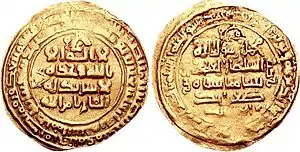Al-Qa'im (Abbasid caliph at Baghdad)
Al-Qa'im bi-amri 'llah (Arabic: القائم بأمر الله, lit. 'he who carries out the command of God'; 1001 – 2 April 1075) was the Abbasid caliph in Baghdad from 1031 to 1075. He was the son of the previous caliph, al-Qadir.
| Al-Qa'im bi-amri 'llah القائم بأمر الله | |||||
|---|---|---|---|---|---|
| Khalīfah Amir al-Mu'minin | |||||
 | |||||
| 26th Caliph of the Abbasid Caliphate Abbasid Caliph in Baghdad | |||||
| Reign | 29 November 1031 – 2 April 1075 | ||||
| Predecessor | Al-Qadir | ||||
| Successor | Al-Muqtadi | ||||
| Born | 1001 Baghdad, Abbasid Caliphate now Iraq | ||||
| Died | 2 April 1075 (aged 73–74) Baghdad, Abbasid Caliphate now Iraq | ||||
| Consort | Khadija Arslan Khatun (daughter of Chaghri Beg) | ||||
| Issue | Muhammad Dhakirat | ||||
| |||||
| Dynasty | Abbasid | ||||
| Father | al-Qadir | ||||
| Mother | Badr al-Dija (Qatr al-Nida) | ||||
| Religion | Sunni Islam | ||||
Biography
During the first half of al-Qa'im's long reign, hardly a day passed in the capital without turmoil. Frequently the city was left without a ruler; the Buwayhid ruler was often forced to flee the capital. While the Seljuk dynasty's influence grew, Chaghri Beg married his daughter, Arslan Khatun Khadija,[1] to Al-Qa'im in 1056.[2]
The Seljuk ruler Toghrül overran Syria and Armenia. He then cast an eye upon Baghdad. It was at a moment when the city was in the last agony of violence and fanaticism. Toghrül, under cover of intended pilgrimage to Mecca, entered Iraq with a heavy force, and assuring the Caliph of pacific views and subservience to his authority, begged permission to visit the capital. The Turks and Buwayhids were unfavorable, but Toghrül was acknowledged as Sultan by the Caliph in the public prayers. A few days after, Toghrül himself — having sworn to be true not only to the Caliph, but also to the Buwayhid amir, al-Malik al-Rahim, made his entry into the capital, where he was well received both by chiefs and people.
During this and the previous caliphs' period, literature, especially Persian literature, flourished under the patronage of the Buwayhids. The famous philosopher al-Farabi died in 950; al-Mutanabbi, acknowledged in the East as the greatest of Arabic poets, and himself an Arab, in 965; and the Persian Abu Ali Husayn ibn Abdallah ibn Sina (Avicenna) in 1037.
In 1058 in Bahrain, a dispute over the reading of the khutba in Al-Qa'im's name between members of the Abd al-Qays tribe and the millenarian Ismaili Qarmatian state prompted a revolt led by Abu al-Bahlul al-Awwam that threw off Qarmatian rule and led to the unravelling of the Qarmatian state which finally collapsed in al-Hasa in 1067.[3]
Succession
Al-Qa'im died in 1075 at the age of 73–74. He was succeeded by his grandson Al-Muqtadi as the twenty-seventh Abbasid Caliph.
Al-Muqtadi was born to Muhammad Dhakirat ibn al-Qa'im, and an Armenian slave girl.[4]
See also
- Qavurt, brother-in-law of caliph Al-Qa'im
- Alp Arslan, brother-in-law of Caliph Al-Qa'im
- Avicenna also known as Ibn Sina was a polymath, physicians, astronomers, thinkers and writers.
References
- Bosworth, C. E. (1968). "The Political and Dynastic History of the Iranian World". In Boyle, J. A. (ed.). The Cambridge History of Iran. Vol. 5. Cambridge University Press. p. 48.
- Bosworth, C. E. (1970). "Dailamīs in Central Iran: The Kākūyids of Jibāl and Yazd". Iran. 8 (1): 73–95 [p. 86]. doi:10.1080/05786967.1970.11834791 (inactive 2021-01-17). JSTOR 4299634.CS1 maint: DOI inactive as of January 2021 (link)
- Larsen, Curtis E. (1984). Life and Land Use on the Bahrain Islands: The Geoarchaeology of an Ancient Society. University Of Chicago Press. p. 65. ISBN 0-226-46906-9.
- Bennison, Amira K. (2009) The Great Caliphs: The Golden Age of the 'Abbasid Empire. Princeton: Yale University Press, p. 47. ISBN 0300167989
Sources
- Bosworth, C. E. (1968). "The Political and Dynastic History of the Iranian World (A.D. 1000–1217)". In Boyle, John Andrew (ed.). The Cambridge History of Iran, Volume 5: The Saljuq and Mongol Periods. Cambridge: Cambridge University Press. pp. 1–202. ISBN 0-521-06936-X.
- This text is adapted from William Muir's public domain, The Caliphate: Its Rise, Decline, and Fall.
Al-Qa'im (Abbasid caliph at Baghdad) Born: 1001 Died: 2 April 1075 | ||
| Sunni Islam titles | ||
|---|---|---|
| Preceded by Al-Qadir |
Caliph of Islam Abbasid Caliph 29 November 1031 – 2 April 1075 |
Succeeded by Al-Muqtadi |